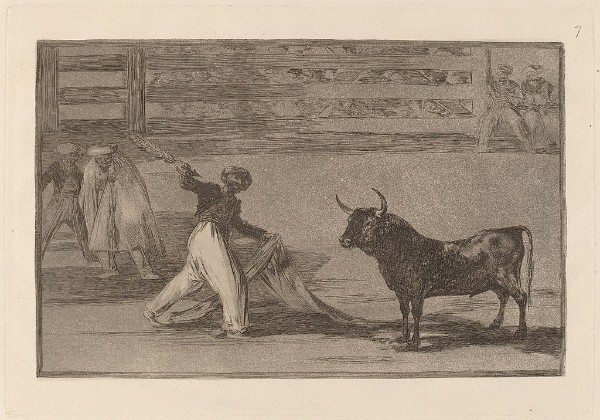The master ceramic designer Johann Joachim Kändler observed the world around him and re-created it for the ceramic company Meissen.
Kändler, through his work, established the appropriate scale and style for porcelain figures, based on his previous training as a sculptor, and one of his inventions was the small-scale figure, which was quickly copied by other porcelain factories across Europe.
Between 1750 and 1760, Kändler and his assistant Friedrich Ellias Meyer created a large series called the ‘Galant Orchestra.’ Each figure, modeled on Dresden courtiers and not the real instrumentalists at the court, is shown with an instrument or singing. These were created to be used as table decorations, augmented by edible sculptures of sugar or marzipan. Without the confectioners’ additions, the figurines were perfect for collecting and displaying in cabinets and were the start of the world of ‘collectibles’ that so many people follow today.
Some of the figures were done multiple times and one model of a flautist is of interest.
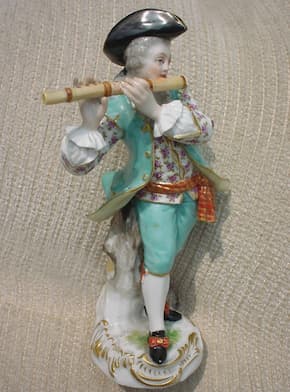
Kändler: Galant Orchestra: Flautist (Smithsonian)
This image shows us a particularly interesting point in musical history. The flautist is playing what was known as the ‘German flute,’ a transverse flute that is ancestor to our modern flute. It would have been made of wood or ivory, with perhaps one or two metal keys at the foot of the instrument. At the player’s feet lies a recorder. In the mid–18th century, when these figures were being made, the recorder was falling out of favor, replaced by the more dynamic flute. It had a greater tonal range and was better at sound projection than the recorder. We can see in this figurine that our player has set aside his old instrument in favour of his new one.
The flute player at the Dresden court was Johann Joachim Quantz (1697-1773) and his influence was carried through his highly influential book On Playing the Flute (1752). Frederick II, King of Prussia, owned 11 flutes made by Quantz.
Johann Joachim Quantz: Flute Sonata No. 272 in F Major, QV 1:93 – I. Allegro (Verena Fischer, flute; Klaus-Dieter Brandt, cello; Leon Berben, harpsichord)
The Galant orchestra (selection)
The Conductor is shown with his score in his hand. This was before batons were used, and the conductor beat time with his hand.
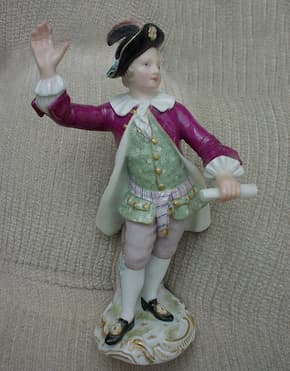
Kändler: Galant Orchestra: Conductor
The wind players include a bassoonist, a flautist playing an over-large wooden flute, a trumpet player, and a player of an indeterminate woodwind.
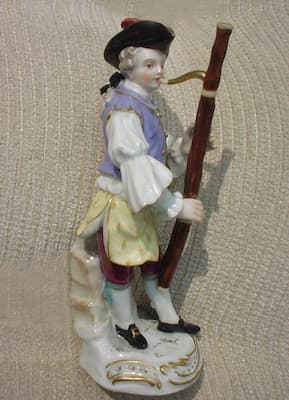
Kändler: Galant Orchestra: Bassonist
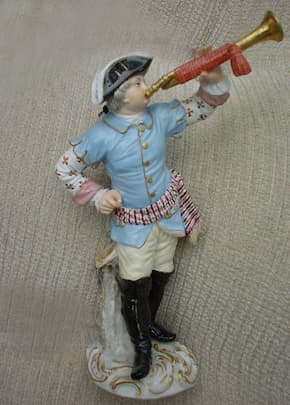
Kändler: Galant Orchestra: Trumpet player
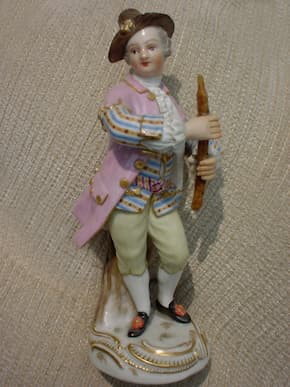
Kändler: Galant Orchestra: Woodwind
In the string section, we have 2 different violin players, both playing with the instrument balanced on their shoulder, rather than under their chin as they do nowadays. The viola da gamba player is shown in an unusual pose – standing. Gambas were played placed on the bend calves of the performer, not placed on the ground like this.

Kändler: Galant Orchestra: Violinist
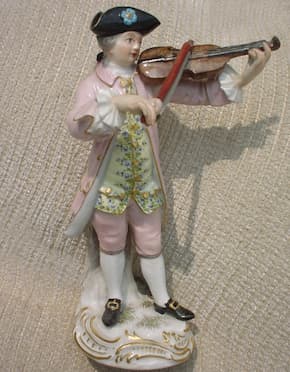
Kändler: Galant Orchestra: Violinist 2
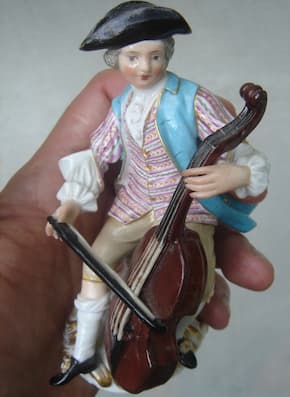
Kändler: Galant Orchestra: Gambist
We round out this selected orchestra with a harp player – again, shown standing, which would be a highly unusual position for a harpist.
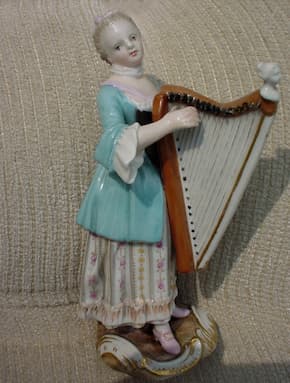
Kändler: Galant Orchestra: Harp Player
Johann Adolf Hasse: Il Ruggiero: Sinfonia – I. Maestoso e staccato (Bavarian Chamber Philharmonic Orchestra; Reinhard Goebel, cond)
A couple of other instruments, more associated with folk music rather than court music are also in the series. A mandolin player is shown in much more casual clothes: he has a scarf draped around his waist and his waistcoat is unbuttoned, probably in reference to the idea of the mandolin being more of a folk instrument. The hurdy-gurdy or vielle player is also shown in a more casual style.
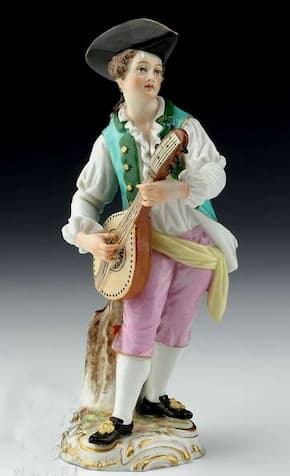
Kändler: Galant Orchestra: Mandolin player
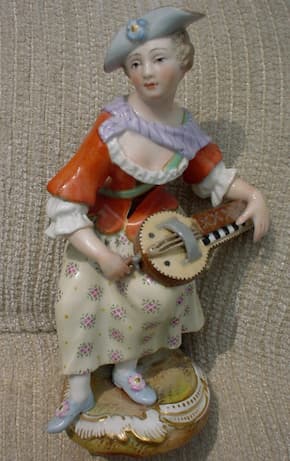
Kändler: Galant Orchestra: Hurdy-Gurdy player
Michel Corrette: La belle vielleuse: Menuets (Robert Mandel, hurdy gurdy)
A number of singers are also portrayed, each in a different gown. The male singer is shown in an elaborate long waistcoat with gold buttons and hold a piece of music in his hand.
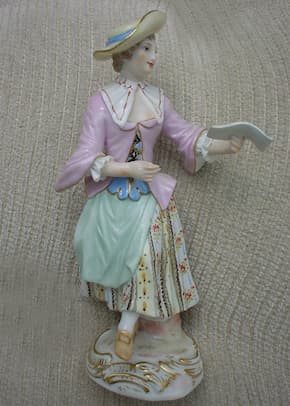
Kändler: Galant Orchestra: Female Singer
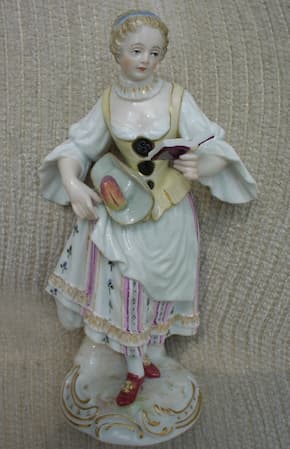
Kändler: Galant Orchestra: Female Singer

Kändler: Galant Orchestra: Female Singer
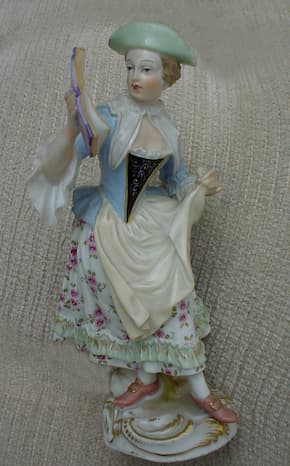
Kändler: Galant Orchestra: Female Singer
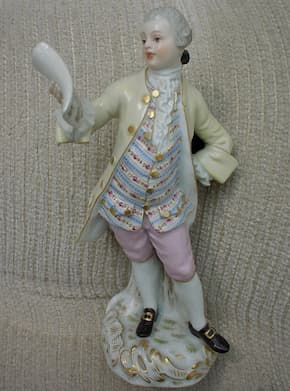
Kändler: Galant Orchestra: Male Singer
This isn’t the complete orchestra – we’re lacking the entire percussion section, for example – so the next time you’re looking at a Meissen instrumentalist, see if they’re part of this ensemble.
One other ensemble that Kändler created for Meissen was another entire orchestra, but all the players were monkeys, including the conductor. The collection below has figures made in the 18th century (a singer); the 19th century (keyboardist, bagpiper, and violinist), with all the rest from the 20th century. However, all are from the original Kändler designs.
For more of the best in classical music, sign up to our E-Newsletter

Meissen Monkey Orchestra


